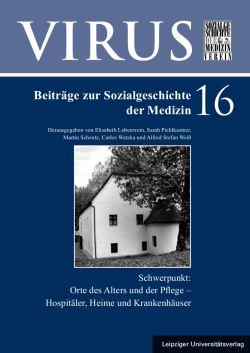 Martin Scheutz
Martin Scheutz
S. 023 - 042
doi:
10.1553/virus16s023doi:
10.1553/virus16s023
Abstract:
Though we have some key studies for Austrian hospitals covering aspects such as economic history or some profound “History of Our House”, historical research still feels the need for historical approaches to the history of staff within early modern hospitals. Little is known about the history of male and female wardens and attendants in hospitals. The Austrian hospital system in early modern times is characterized by contrasts; some big hospitals such as the imperial hospital in Vienna (“Hofspital”) were confronted with many small hospitals for six or twelve inmates. In small hospitals “healthy” inmates served as caretakers for older and sicker inmates – sound inmates also had a large share in running small hospitals in general. Therefore, distinct divisions between inmates and staff in those hospitals are hard to find. Big hospitals, on the other hand, had a structured and multilayered administrative hierarchy. At the top we normally find a “superintendent”, a high-ranking person as delegate of the city council, followed, on the second level, by a hospital master who was in charge of the hospital’s internal affairs. On the third level “house officers” are found and finally, the basic level comprised hospital staff such as hospital stewards, cooks and caretakers. Beside the writing control of the hospitals (such as the hospital recorder) and the administering supervision (such as custodian of the grain) the care taking in hospitals was an essential part of managing such houses: male and female nurses, master of infirm people (“Siechenmeister”), custodians for orphans can be found in larger institutions. Based on instructions and house rules, fields of activity of the care taking staff in hospitals form core questions of the following paper. Little is known about the history of wardens in hospitals: the recruitment of those people, pension schemes and income levels have not yet been scientifically examined.
Hospital organization, hospital staff, care work and care staff in Early Modern Austrian hospitals, house officers, instructions, house rules
Published Online:
2020/07/22 20:40:09
Object Identifier:
0xc1aa5576 0x003bb5bf
Rights:https://creativecommons.org/licenses/by/4.0/
Die Zeitschrift "Virus - Beiträge zur Sozialgeschichte der Medizin" ist das Publikationsorgan des Vereins für Sozialgeschichte der Medizin und erscheint einmal jährlich.
Sie versammelt wissenschaftliche Beiträge verschiedener Disziplinen, die sich mit Themen aus den Bereichen Medizin, Gesundheit und Krankheit in historischer, kultur- und/oder sozialwissenschaftlicher Perspektive empirisch auseinandersetzen. Weitergehende Einschränkungen für Beitragsvorschläge in thematischer oder methodischer Hinsicht bestehen nicht.
Der "Virus" publiziert vornehmlich Beiträge mit Bezug zur Geschichte der Medizin in Österreich, dessen Nachbarländern sowie der ehemaligen Habsburgermonarchie. Vergleichend angelegte Arbeiten können aber über diesen Rahmen auch hinausgreifen. Hinsichtlich der behandelten Zeiträume bestehen keine Eingrenzungen, jedoch stehen Beiträge zur Medizin in der Neuzeit und der Moderne/Postmoderne im Vordergrund (16.-21. Jahrhundert).
…




 Home
Home Print
Print
 References
References
 Share
Share
 Martin Scheutz
Martin Scheutz